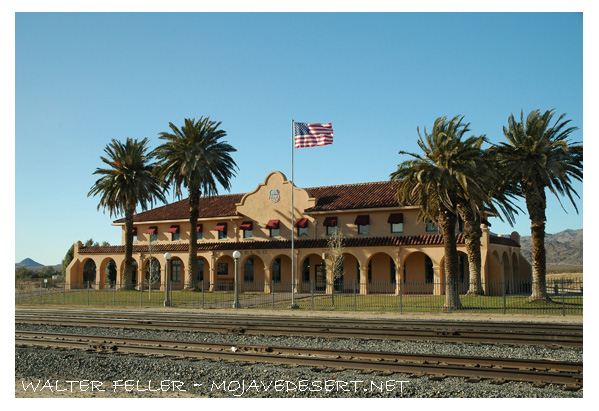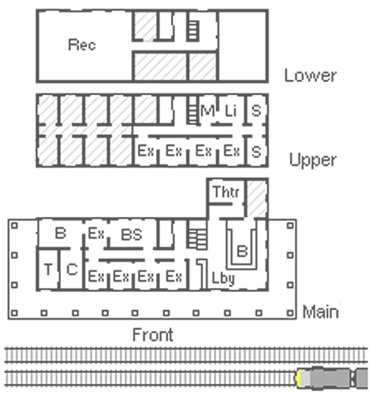Mojave Preserve - Kelso, CA
Kelso Depot
click the photo to continue
Front of Kelso Station
A Railroad Through the Desert
Kelso Depot seems like a quiet anomaly in the middle of the desertbut for the Union Pacific Railroad it was a thriving necessity Since its inception in 1862 the Union Pacific UP wanted a foothold on the west coast After reaching Portland Oregon UP turned its attention to the rich California markets and the ports around Los Angeles To get there it needed to construct a railroad across the Mojave Desert Kelso was crucial to reaching that goalSan Pedro Los Angeles Salt Lake Railroad
In August 1900 Utah Senator William A Clark a wealthy mine owner bought a small railway in Los Angeles With this purchase he then started construction on what would become the San Pedro Los Angeles Salt Lake Railroad In 1902 UP made a deal with Clark and purchased half the stock of the railroad before it was even completedConstruction of the line known as the Salt Lake Route began at the two ends near Salt Lake and Los Angeles and spread across the Mojave Desert in between By 1905 the route had grown to nearly 235 track miles and reached Siding 16 The site gained its present name when two warehousemen put their names into a hat along with that of a third worker John Kelso They drew out a name and Siding 16 was renamed Kelso
By the end of 1905 the track stretched from the west coast port of San Pedro to Salt Lake City giving UP access to markets in southern California Later UP persuaded Senator Clark to sell his stock in the Salt Lake Route giving UP full ownership of the line
A Railroad Town at Kelso
The steep two percent grade from Kelso to Kessler Summit later renamed Cima meant that helper engines would need to be stationed nearby to assist locomotives up the 2078 foot ascent Additionally steam locomotives of the era desperately needed water Kelso had a reliable water source from a spring in the Providence Mountains so it became the site of the helper engine stationThe first depot at Kelso opened in 1905 followed a few months later by a post office an engine house and an eating house to serve railroad employees and passengers on trains without dining cars Over time the town grew as more workers were needed and their families moved to Kelso to join them
The Kelso Club House Restaurant
In the early 1920s the Los Angeles Salt Lake Railroad began planning for new depots restaurants and employee facilities at several towns including Kelso The railroad chose to design these new buildings in the Spanish Mission Revival style Interrailroad competition was lively and UP was determined to put up buildings that would rival the Harvey Houses of the Santa Fe lines The style would as UP Chairman Lovet wrote add very little to the expense but a great deal to the appearance of the place It is a dreary country and the lack of anything of this sort contrast very conspicuously with the Santa FeRailroad civil engineers in Los Angeles drew up plans in 1923 labeling the drawing Kelso Club House Restaurant For UP a Club House was a company rooming and boarding house with recreational facilities in later years the building was commonly called the Kelso Depot The building would have a conductors room telegraph office baggage room dormitory rooms for staff boarding rooms for railroad crewmen a billiard room library and locker room Construction started in 1923 and the depot opened in 1924
Originally the restaurant sometimes called The Beanery and telegraph office were operated around the clock This continued through the boom years of the 1940s and 50s when Kaisers Vulcan mine contributed to Kelsos growth In those years the population grew to nearly 2000 When the mine closed and diesel engines replaced steam jobs and families moved away from Kelso The depot function ended in 1962 although the restaurant and boarding rooms remained in use In 1985 with a dwindling need for crew members to eat or stay overnight UP decided to close the Kelso Depot
Life After Closing
Believing that the nowempty Depot would become a target for vandalism unauthorized entrance and a legal liability UP Division Superintendent GR Jenson made plans to raze the building Local residents and others across the region heard about the proposed demolition and began to publicize the buildings plight The group organized the Kelso Depot Fund and set about saving the building After successfully halting demolition however they found the costs of restoration too expensive and turned to local politicians and the federal government for assistance At that time the Bureau of Land Management BLM already managed much of the land around Kelso as the East Mojave National Scenic Areait made sense for the BLM to gain ownership of the Depot Members of Congress from the area went to work and by 1992 the BLM had the title to the building With the passage of the California Desert Protection Act of 1994 the East Mojave National Scenic Area became Mojave National Preserve and the Depot passed into the hands of the National Park Service Renovation began in 2002 Kelso Depot reopened to the public as the primary visitor center for Mojave National Preserve in October 2005Source - NPS
Kelso Depot Floor Plan

Building Exterior
Front of depot
Arcade from east
Arcade from west
Tracks from front
Main Floor
Lobby
Beanery
Theatre
Exhibit room
Exhibit room
Exhibit room
Exhibit room
Bookstore
Exhibit room
Baggage room
Ticket/Telegraph Office
Conductor's Office
Second Floor
Exhibit room
Exhibit room
Exhibit room
Exhibit room
Sleeping quarters
Sleeping quarters
Library
Map room
Basement
Meeting Room